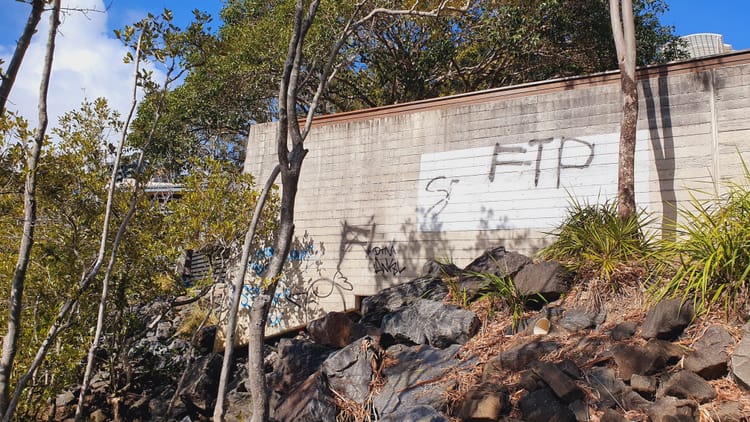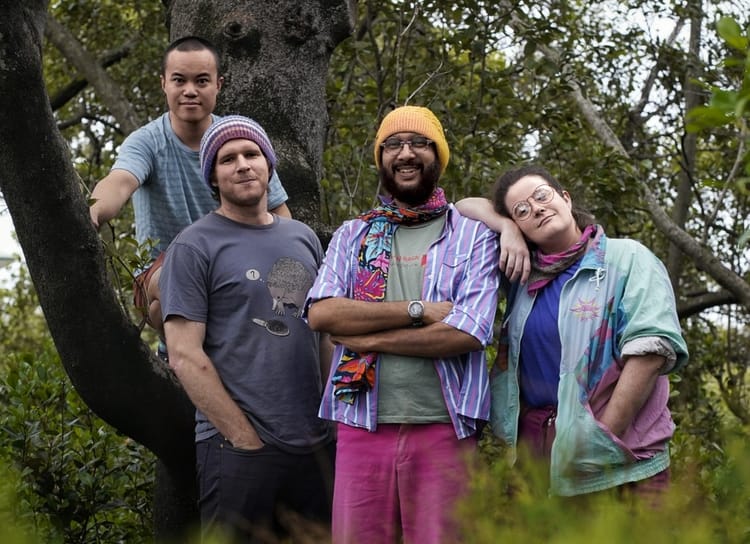The inefficiencies of centralised administration and service provision: 3 local council case studies
As an addendum to this much longer article, I've jotted down the following case study experiences from my time as a city councillor, which I think exemplify the limitations of centralised, top-down approaches to governance and service provision.
1. Maintenance of public spaces
Fairly frequently during my time as a councillor, residents would report legitimate concerns about street tree branches hanging too low over footpaths. Usually these were small jobs that didn't require a chainsaw and could've been handled by an amateur with a decent pair of clippers, but council local laws technically prohibit residents from pruning street trees themselves without first applying for a council permit (the permit application process itself is quite bureaucratic, and doesn't meaningfully protect street trees from over-zealous pruning by residents anyway).
If footpath users feel a tree is overgrown and want the council to address this, the council system requires two steps of internal comms:
1. Resident (or a city councillor's ward office) reports issue to contact centre, whose staff record the details and forward them to whatever the public space management team is called (team names and responsibilities were changing all the time).
2. A team manager then reviews the request and assigns the job to a particular field worker.
For this chain of communication to work, a lot of secondary roles are also necessary – IT support to maintain the complex systems for logging and forwarding jobs, supervisors to train contact centre workers to understand how to log different kinds of requests etc.
To avoid driving all over town for one-off jobs, the worker (understandably) waits until there are a few different trees needing maintenance in the same neighbourhood. So by the time they get out there, several weeks – or sometimes even a couple months – might have passed, by which time the branches have grown and the job is bigger.
Of course, it might be more efficient if one public servant was responsible for a wider range of tasks e.g. the guy who goes out to patch a pothole on a street also trims a few tree branches, picks up an old couch someone abandoned on the footpath, and checks the stormwater drainage pits for obstructions all at the same time – that's how a handyman or groundskeeper employed my a smaller org like a school or retirement village might (once) have done things. But the council's compartmentalised, highly-specialised approach to place management precludes those kinds of efficiencies – only an accredited drainage specialist can be trusted to look down the grates and make sure the pits aren't clogged with litter or mud!
If the thousands of Brisbane residents who do still undertake basic street tree pruning and gutter clearing stopped doing that kind of work or, for that matter, stopped weeding/mowing the grassy, council-owned strips of public land in front of their houses, the council's public space maintenance budget would have to increase tenfold. Or more likely, that work just wouldn't get done (maybe overgrown weedy footpaths would become a more ecologically abundant haven for insects, but that's another conversation).
Interestingly, the council sometimes declines requests to plant street trees in certain areas because it doesn't have the staffing power to come out and water one lonely sapling while it's getting established, even though my experiences with establishing community gardens and orchards shows that there are definitely plenty of residents and business owners out there who'd be willing to help with this if that were normalised as part of the social contract.
If the council's main concern is that residents can't be trusted to maintain local trees without harming them, it could instead focus on working with local community groups to assist in public education. But most residents in most parts of the city have been trained into a more ruthlessly transactional client-service provider relationship with the council – "I pay my rates, and in return I expect the council to maintain the public space in front of my house." So the council would also now have to do a lot of work shifting underlying culture and redefining that relationship if it wanted to rely more on residents for this kind of work.
2. Minor road safety upgrades
In a quiet residential neighbourhood, residents realise that when larger cars are parked at a certain spot along their street, it creates a dangerous blind spot for turning vehicles and pedestrians crossing the road. After talking to each other, they decide it would be best to install a yellow line along the kerb to ban parking there.
To prep the surface and neatly paint a 5 metre-long yellow line along the street edge might take one of the residents up to an hour of work – maybe two hours all up if they also have to go out to buy some weather-resistant yellow road paint. Between the households on the street, they probably already have all the necessary painting equipment, and because they live locally, it’s easy to find a time when the road is clear and safe to work on. It’s a simple job that at most costs a couple hundred dollars in materials and labour (though the residents would most likely just volunteer their time). But of course local laws prohibit painting your own road markings on a public road.
If, instead, residents request that Brisbane City Council address this safety concern, the process will be significantly slower, and at least twenty times costlier…
The request will have to be logged by a call centre worker and allocated to the relevant council department. Because the council doesn’t trust the judgement of a group of local residents about road safety matters like this, the team manager will ask a well-paid council traffic engineer to review the request. That engineer will have to travel to the location in person, take some measurements and photos and (assuming they agree with the blind spot concerns) draw up a plan for the yellow line – which the manager then reviews and approves – before it’s forwarded to the works team. Ideally someone will also get back to the residents to confirm their request has been agreed to.
The council works team gets the request and adds it to the list of upcoming jobs for the line-marking crew. That crew can’t just rock up to paint the line, because there’s a high chance some unwitting visitor to the street will have parked a car in the way. So they first have to ask another council worker to deliver notification letters to all the nearby households, put up signs on the street about the upcoming work, and leave out some traffic cones so no-one parks in the spot where the yellow line needs to go.
Painting the line constitutes working on a roadway (even though it’s in a parking lane, away from moving traffic), and the line painter can’t just duck out on a Sunday arvo or late on a weekday evening when there’s less traffic. So although this is a fairly low-traffic street, a council project manager also has to organise (and pay) traffic controllers to attend while the work is undertaken. Assuming there are no interruptions due to wet weather, in a best case scenario the yellow line will be painted two to three months after the residents requested it, at a cost to ratepayers of a couple thousand dollars’ in staff time.
Exasperated yet?
Note that none of the inefficiency described above is due to private sector outsourcing, or under-funding of council departments. It’s a predictable consequence of a service being delivered by a large, centralised administration where the people doing the work aren’t locally based.
In my experience, such projects can become even more bureaucratic, because the council is so disconnected from the community that public servants often aren’t sure whether the residents who requested the line (or some other kind of road safety improvement) are representative of broader neighbourhood sentiment. So the team might want to conduct more ‘consultation’ first to ensure there aren’t strong objections to the loss of the parking spot.
Siloed, unrepresentative consultation processes – which primarily empower those residents who have the most free time to follow and respond to council communications – thus end up substituting for more meaningful forms of democratic decision-making where residents might have talked to each other directly (as opposed to each of them just individually communicating with the council).
3. Responding to a natural disaster
(I've used the term 'natural disaster' for this section, but it's good to remember that what we call 'natural' disasters are often a result of humans making bad decisions, such as allowing property developers to concentrate new construction on a floodplain.)
After Brisbane’s 2011 floods, a ‘mud army’ of thousands of self-organising volunteers helped clean flood-affected homes and businesses, but also caused some traffic and parking issues, with so many people driving into flood-affected neighbourhoods to assist with the clean-up. There were also isolated reports of over-enthusiastic volunteers throwing out salvageable flood-damaged possessions, and safety risks (both genuine and exaggerated) associated with untrained, unsupervised residents entering flood-affected areas (drainage pits without lids, damaged electrical infrastructure, structures that might collapse etc).
So for the March 2022 flood cleanup, Brisbane City Council partnered with Volunteering Queensland to establish a central portal to recruit and coordinate volunteers, explicitly discouraging residents from proactively driving across town to look for households and businesses requiring help. 16 747 residents signed up, but in the days immediately after floodwaters receded, the council held off deploying these volunteers, partly because of predictions that further severe storms might hit the city. Eventually, the council asked volunteers to travel to muster stations in different parts of the city, put them through over an hour of processing and inductions, then bussed them to flood-affected neighbourhoods where supervising council officers instructed them to only assist with specific, low-risk cleanup tasks (for example, they were advised against helping to clean my houseboat neighbour’s mud-soaked jetty and access path because the boats weren’t considered dwellings and the task was ‘too risky’).
In the end, only 1795 volunteers (barely 10% of signups) were actually deployed via ‘official’ council channels, a full week after flooding rains hit the city. By that time, most of the straightforward, labour-intensive cleanup work had already been undertaken by smaller, locally-embedded community organisations and self-organising networks of neighbours.
On Brisbane’s inner-south side, Max Chandler-Mather’s election campaign team combined with my Gabba Ward office and Amy MacMahon’s state electorate office to recruit and direct cleanup volunteers much faster and more efficiently than the council. In suburbs like East Brisbane and West End, by the time the council officers and officially-vetted volunteers rocked up on the Saturday, many flood-affected residents were saying “no thanks, we’re fine, the Greens already came and helped us out.”
This experience mirrors patterns across the country and the globe where, in the aftermath of disasters, local community-driven clean-up efforts frequently prove to be more effective, human-centred, context-responsive and flexible than state-led responses.
It should also be noted that because many flood impacts and much of the cleanup work isn't legible or apparent to the centralised nation-state, the full consequences and costs of building on a floodplain are underestimated by government authorities, who continue to allow more development in flood-vulnerable locations.
Does anyone think this is a good way to do things?
I have dozens more examples like the ones above. What interests me the most is that even when you talk to council workers themselves, they often identify – without prompting – that much of the work they're responsible for good (both day-to-day and in times of crisis) could be carried out more efficiently by local community groups or individual residents. When the people working in these roles acknowledge that administration and coordination of council responsibilities could and should be decentralised and localised, surely this tells us that something ought to change?
I'm cautious of over-generalising about how all governments work based solely on experiences with Brisbane City Council, but I've observed similar patterns when involved as a stakeholder in state or federal government projects and decisions, and in conversations with other elected reps from various Australian jurisdictions.
Anyway if you haven't already done so, check out my main article on this topic, which explores the phenomenon in greater depth.






Member discussion